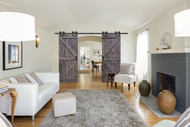How to Make Your Home More Energy Efficient
Dec 18th 2018
Would you like to make your home more energy efficient, environmentally friendly, and save money? It’s hard to say “no” to all of that. Here are some great ways you can make small changes at home that will impact your bottom line, energy usage costs, and help the environment.
Adjust Your Thermostat
When you are not at home, depending on the season, lower (in winter) or raise (in summer) the temperature on your thermostat. A change of just three to five degrees will use less energy and lower your utility bill. During the work day, if you work outside the home, adjusting your thermostat by 10 to 15 degrees will save 5% to 15% annually. That’s significant savings and there’s no reason you should be heating or cooling an empty house.
Watch
Your Water Usage
According the U.S. Environmental Protection Agency (EPA), the typical homeowner
can save about $170 a year by making small changes. Be aware of leaving
the water running while brushing your teeth or shaving. Also, consider this: a
bath uses approximately 75 gallons of water versus a shower that uses on
average 17.2 gallons.
When you do laundry, do full loads of laundry. Running half-loads means fewer clothes are getting clean with the same amount of water. Full loads conserve water and are more efficient. Additionally, avoid using hot water and go with cold or warm water when you can. Close to 90% of the energy your washer use is to heat the water for a load, the other 10% runs the machine. Cooler water in your wash loads can save a significant amount of energy.
Give Your HVAC a Tune-Up
A yearly check of your heating and cooling systems will make sure your furnace and A/C are at peak efficiency. This should save money every month. A check-up improves efficiency by tightening all connections, lubricating all parts, and cleaning all coils. An HVAC tune-up can also help you avoid replacing your furnace--a cost of $2000 to $8000.
Get a New Computer
According to most tech experts, you should replace your computer every four
years. If you have a desktop computer that needs replacing, consider replacing
it with a laptop. Laptops use up to 80% less electricity and run on less energy
than desktops. Laptop computers normally draw a maximum of only 60 watts, while
most desktops draw closer to 175 watts. While laptops don’t always come with a
cheap price tag, they are greener and certainly more portable.
Open Your Doors
Open interior doors allow for air flow, which increases energy efficiency. Regardless of what you feel, the air in your home is constantly moving, driven by flowing air from the HVAC system as it heats up and cools down. Leaving the doors open in your home allows air to move more easily throughout the house, carrying cool or warm air throughout. When you keep the doors shut, this movement is halted, although not stopped. There are cracks in, above, and under doors where air will still flow, but it makes movement much harder.
Energy Proof On-the-Spot . . . a few things you can do TODAY!
Do simple things like turning off your computer monitor for long periods of downtime. The monitor uses over half the system's energy. There is no reason to leave it on if it is not being used.
Unplug battery chargers when not in use. Chargers for cell phones, laptops, and
other wireless devices use lots of energy even when they aren't actually
charging anything.
When you aren't in the room, turn off the lights. Or install timers or motion sensors to reduce the amount of time your lights are on.
There are so many ways to make your home more energy efficient, even small things you can do today without spending a cent as shown in this last example. Try a few of these tips today, add a few more, maybe take on a larger project toward efficiency, the savings will flow as will the energy efficiency.
There are so many creative ways to bring interior doors into your home where they now don’t even exist. Barn doors, for example, make great interior doors for energy efficient homes. They will allow you to create separate spaces for energy efficiency and then change to open spaces for other functions. Barn doors are functional, attractive, easy-to-install and don’t need a full-on doorway to work. You can create an energy efficient space anywhere in your home with the installation of a barn door. Have questions? Let us know, we can help.
